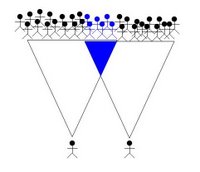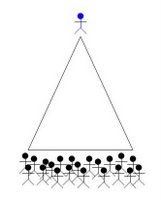 Many of the individual family history sites on the internet are in this format. This can be beneficial to some people, particularly nuclear families and a few cousins who share much of their ancestry in common. However, I don’t think this model is maximally effective for collaborative family history efforts. Why do I believe this? First, only you and your biologically full siblings share exactly the same pedigree. Everyone else has other people in their pedigree who are not your ancestors and therefore probably interest you very little. Second, these efforts frequently lack focus and concentrated effort when it comes to collecting and disseminating the histories of single individuals or families. Families usually collect a bundle of names, but, in the end, they know very little about any one of their ancestors. Even when large extended families find common ancestors who interest them, they often get spread too thin to really delve into the personal histories of these people.
Many of the individual family history sites on the internet are in this format. This can be beneficial to some people, particularly nuclear families and a few cousins who share much of their ancestry in common. However, I don’t think this model is maximally effective for collaborative family history efforts. Why do I believe this? First, only you and your biologically full siblings share exactly the same pedigree. Everyone else has other people in their pedigree who are not your ancestors and therefore probably interest you very little. Second, these efforts frequently lack focus and concentrated effort when it comes to collecting and disseminating the histories of single individuals or families. Families usually collect a bundle of names, but, in the end, they know very little about any one of their ancestors. Even when large extended families find common ancestors who interest them, they often get spread too thin to really delve into the personal histories of these people. Therefore, I think that a more effective way of doing family history on the internet is by picking one or two ancestors and focusing on them. This format lends itself more readily t o collaborative efforts as dozens and sometimes even hundreds of people will share that common ancestor. This ancestor then becomes a rallying point for several generations, which helps people to connect and interact, it imbues families with a sense of pride and identity, and it provides a collection point for family history information.
o collaborative efforts as dozens and sometimes even hundreds of people will share that common ancestor. This ancestor then becomes a rallying point for several generations, which helps people to connect and interact, it imbues families with a sense of pride and identity, and it provides a collection point for family history information.
One of the trials of family history work is that as families get larger and have more descendants, information and artifacts often become haphazardly dispersed. Let’s say, for instance, that one of your ancestors has four prized possessions: an old family photograph, a journal, a family Bible, and a beautiful old armoire. As things usually go, one child will get the photograph, another will get the journal, another will get the family Bible, and another will get the armoire. With the passage of time, these artifacts get spread out among children and grandchildren, and eventually nobody knows they exist, except for the person who actually possesses the artifact. The beauty and blessing of the digital age is that we can now easily share almost all of the information listed. The photograph and journal could be digitized and sent as email or posted on a blog or internet site. In my family, for instance, I’ve inherited a 1921 photograph of John Richards Howard, his son, John Fitz Alan Howard, and his grandson, Gordon Maxwell Howard. If I hadn’t posted it on this blog site, nobody would know that I have it and nobody else would have access to it. PDFs or transcriptions of notes written in the family Bible could likewise be shared. The only thing that can’t easily be shared is the nice armoire, but that’s okay because there are many things in life that are more important than nice armoires.
Fortunately, it’s now easier than ever to share photos, writings, and audio & video snippets. And, once again, a blog or website that acts as a family rallying point is the ideal location to share this information. Establishing a web presence with with a blog is relatively simple, particularly with a program such as Google's Blogger. Anybody can set up a blog page for an ancestor. It’s free and requires virtually no understanding of webpage design. Furthermore, a blog is the ideal format for the exchange of ideas and information. Material that is posted on the blog is available for all to see, and anyone visiting the blog can comment on the content. This is great for family history because histories and photos can be shared and commented upon. Comments may include new stories, websites, or resources that were previously unknown to the original poster. Even if all a person wants to do is say hi and leave his or her name, it at least lets us know that that person exists and is interested. Every contribution counts and makes a difference.
So what I would encourage is that people pick an ancestor or a single family (for instance a pioneer or pilgrim family) and establish a web presence for that person or family. In this way, all of that person’s or family’s descendants will be able to join in on the dialogue and all will be benefited by the exchange of information. I became interested in John Richards Howard for a few reasons. He had an amazing, fascinating life that spanned 85 years, 3 continents, and a number of challenges and hardships. And, because I bear his surname and Y chromosome, I’m interested in learning a little bit more about his life. Through blogging I'm able to share the information that I have with others, and I hope to be able to learn more about him from visitors to this blog site.

2 comments:
Very cool! I like the "paradigm shift" you recommend using a common ancestor as a "rallying point". Good stuff.
Thanks for the feedback, Jeff. By the way, if anyone who reads this is interested in politics, you should take a look at Jeff's "Iowans for Romney" (http://iowansforromney.blogspot.com/) blog. People are saying that it's the best Romney blog on the internet. Jeff is unusually adept at dissecting complicated issues and making them understandable and palatable. Thanks, Jeff!
Post a Comment